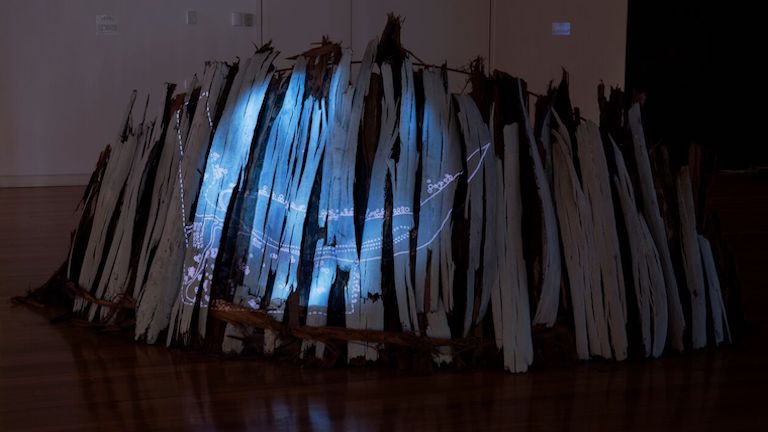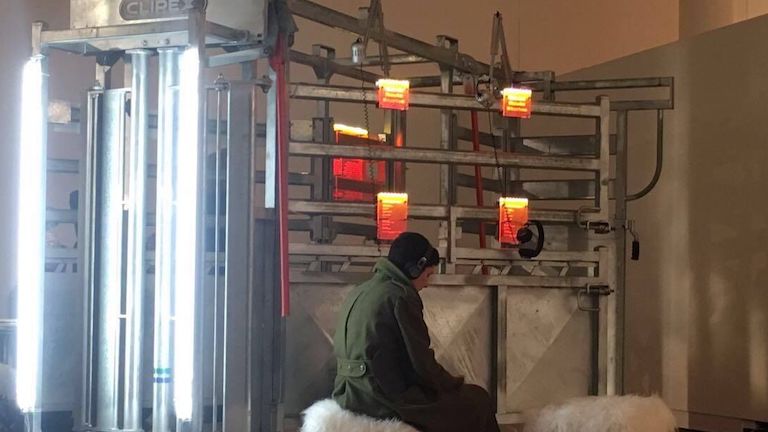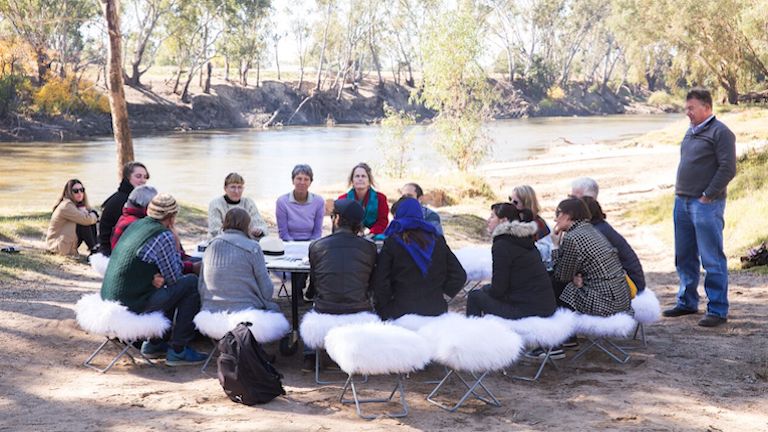A Long Time Coming: The Long Paddock
July 14th 2017
Alexia Giacomazzi

Zanny Begg, The Bullwhip Effect, 2017 (video still).
- The Long Paddock :: Canvas: Art & Ideas
What do you get when a herd crosses the road? A Travelling Stock Route, apparently.
Travelling Stock Routes and Reserves are historic pathways used for moving livestock across the country in times of drought, flood and fire. The method is like back-burning which supports vegetal regeneration in arid environments. On top of this, the shared-use of these public spaces is overwhelming. Everyone from ornithologists to beekeepers take advantage of the wildlife corridors sutured through them.
Sydney Slickers might kick about in leather-soled R.M.s, but when it comes to the outback, few know of these important routes worming across our regional landscapes.
TSRs are testimony to our colonial heritage and come with a complex suite of issues that have remained relatively under-examined outside communities they serve directly.
However, with a recent NSW Government review into the TSRs, there seems no better a time to explore these relics for their community value. Joni Taylor, founder of New Landscapes Institute, commissioned nine artists and architects to produce entirely new works that contemplate the TSRs for The Long Paddock, now showing at Wagga Wagga Art Gallery. The collaborators include Zanny Begg, Megan Cope & Bill Buckley, Hayden Fowler, Future Method Studio, Grandeza, Josphine Starrs & Leon Cmielewski and The Wired Lab.
Together, these practitioners burrow into our colonial past to foreshadow a possible future for these TSRs and the landscapes they transverse.
Their status as public space make them fodder for “the commons” debate that has roots in England, Scotland and Wales: the imperial heartland. So ultimately there’s no way around them. These TSRs have layered narratives that are at times very problematic and therefore warrant our attention.

Future Method Studio, Rylestone Travelling Stock Route, fieldwork for The Long Paddock, 2017. Photography: Rosie Krauss.
Zanny Begg tackles the globalised supply chain and the unpredictability of the market with a spellbinding short film, The Bullwhip Effect, featuring whip cracking star, Emiliqua East. The bullwhip creates a sonic boom that out-competes the speed of the whip itself. Begg uses the whip crack to represent an accelerating and unstable market (here, an obvious reference to agricultural economies) which enforces dramatic change to the Australian landscape through increasingly pressured farming practices. The ramifications of this artwork are multilevel and dizzying. Begg compels us into a discussion of industrialised farming that has widespread relevance to overconsumption and production in other modern economies.
Megan Cope and Bill Buckley create a temporary windbreak structure from reinforced steel and bark. Onto its external surface, they project images of water bodies that delineate ancient Indigenous pathways. Traditional and modern building techniques are commingled in Untitled (Incognito) which performs as a hybrid, architectural structure. It resolves some of the hardships of farming livestock, crops and even camping out bush; but inside the gallery the work curls around a different set of pragmatics.
Untitled raises questions of Indigenous heritage, evidence of land ownership and the complexities of farming grids and infrastructures encroaching upon pre-existing songlines.

Megan Cope & Bill Buckley, Untitled (Incognito), 2017. Photography: Jacob Raupach.
And here we face a matter of some contention even in our cities: what value do we place on our heritage structures or buildings? Or more specifically, which components do we regulate for posterity and which are dispensable to it? Because, let’s face it, we have a habit of cherry-picking.
This is why Cope and Buckley’s gesture of projecting onto the façade of the windbreak is so significant. As Grandeza pointed out during the Public Program: Artist Talks, the façades of historic buildings have special heritage status in Australia which does not translate to their interiors, which, for example, can undergo renovation. This specificity resonates loudly in (Untitled) Incognito because its external wall is made of “ochre sensibilities”, thereon shifting the distinction of heritage. It is an elegant way to address reclamation.
Speaking of Grandeza, an introduction: Grandeza is an academic research cluster hailing from UTS Schools of Design and Architecture. Amaia Sanchez-Velasco, Jorge Valiente and Gonzalo Valiente founded the studio in Madrid, with the shared itinerary of exploring geopolitical issues through spatial practices and collaboration. Luckily for us, they exported their talents.
Their predominating work, The Plant, is a cattle crush embellished with digital accessories including LED lights which lend it a distinctly disco aura. The cattle crush was traditionally used by drovers as a tool for mobilising cattle and was a fairly public object. Today the mechanisation of farming techniques and the industrialisation of land management practices have made the cattle crush a lesser known relic, instead replaced by systems in which animals are not visible in paddocks, but encaged and slaughtered on masse in abattoirs.
The gaudy and glittering plant challenges how we conceive of agricultural practices because we are still sold the image of Old MacDonald.
To demonstrate the dynamic and multipurpose use of the TSRs, Joni Taylor and Grandeza assigned a part of the structure to serve as a listening station complete with auxiliary earphones and fluffy merino stools.

Grandeza, The Plant – Stock Route Stories, 2017. Photography: Grandeza.
The audio interviews contain stories of community members in Dubbo and Wagga Wagga who use TSRs or have had meaningful experiences with them. These include not only drovers but recreationalists and Indigenous persons whose families lived and worked the TSRs for generations.
The project is cumulative and will continue to enfold related stories. The Plant also comes with a textual series of case studies looking at pastoral pathways and transhumance, a migratory farming method with a focus on sustainability. These are printed on porcelain plates and are matched with mapping images which demonstrate where these practices occur globally. This space is aptly called The Parliament.

Grandeza, The Plant, 2017. Photography: Jacob Raupach.
Best of all, these plates are scattered around a cow skin table which folds upwards from the centre and belts together with particularly S&M-looking straps. The table, now a four-legged replicate, can be wheeled around and outside the gallery for on-site roundtable discussions as part of the extended Public Program. Grandeza calls her Margerita and she is totally promiscuous.
During the launch of The Long Paddock, Margerita was taken from Wagga Wagga Art Gallery to two different locations. The first was a nearby, outdoor amphitheatre where artists hosted a discussion about the global ramifications of land management. The cohort considered our relationship with the world we jointly inhabit and which inhabits us.
The second location was alongside the great Murrumbidgee River bordering a local TSR for the event Future Acts featuring Future Method Studio and Wiradjuri Elders Lyn Syme and Kevin Williams. Here, the discussion contoured issues of native title and land rights specific to the experiences of Lyn and Kevin, and to the political obstacles they have faced in protecting the land and their rights to it. The event was an extension of fieldwork Genevieve Murray conducted for Cementa Arts Festival in Kandos earlier this year.

Grandeza, The Plant – Mobile Parliament, 2017. Photography: Jacob Raupach.
This weekend is the final iteration of the Public Program in Wagga Wagga with roundtable discussions on art and agriculture. On topic is how practitioners can influence and contribute to positive change in their environments. The roundtable will be facilitated by artist Dr Lucas Ihlein, who is both a member of the Kandos School of Cultural Adaptation and a Research Fellow at the University of Wollongong. Speakers include conservationist Kylie Durrant, Wiradjuri Elder and artist Lorraine Tye, artist and interdisciplinary researcher Christopher Orchard, Executive Dean of Science at Charles Sturt University Prof Tim Wess, Sarah Last of The Wired Lab and, of course, Joni Taylor representing New Landscapes Institute.
If you have not yet seen The Long Paddock or had the chance to participate in the embroiled and rich discussions between artists, architects, researchers and community stakeholders, pull your boots up and get out there. It is more than worth your while.
Hear all about ‘The Long Paddock’ in this Canvas: Art & Ideas interview above.


